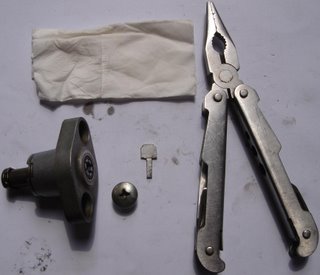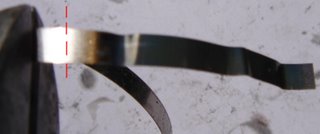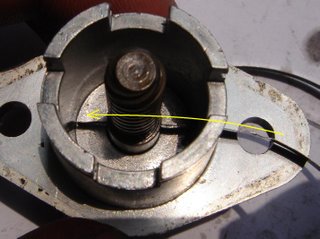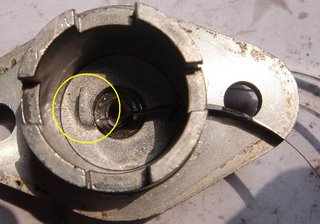Membayangkan mereparasi LAT,
wow… nampaknya susah yak…
Itulah kesan pertama ketika ingin mencoba mereparasi LAT,
tapi jika sudah tahu trik nya, ternyata mudah kok…
Pertama-tama kita siapkan dulu alat-alatnya:
-Kunci Ring/ kunci Sok 10mm,
-Lunci L (Hexagonal) no. 5,
-Obeng Plus/ Philips/ Kembang (yang mata nya besar dan pendek),
-Tang Lancip,
-Kunci LAT (cara membuatnya akan dijelaskan…),
-Kain lap atau tissue.
-Plus lem Sealer Mesin/ gasket LAt baru.

Kunci stopper/ penahan LAT dapat dibuat dari pelat setebal 1 - 1,5 mm, bisa besi atau alumunium, yang penting kaku dan tidak mudah bengkok.
Berikut ukurannya

Langkah pertama yang harus dilakukan adalah mencopot LAT dari mesin,
Caranya lepaskan dulu dynamo starter dari mesin dngan membuka 2 buah baut dengan kunci ring 10mm.
Lalu, buka baut tutup lubang LAT dengan obeng kembang,
Buka juga baut pengikat LAT di mesin dengan kunci L no.5,
Ketuk2 perlahan Body LAT dengan kepala plastic obeng atau dialai dengan kayu agar LAT bisa terlepas dari mesin dan tidak rusak…
Setelah LAT terlepas dari mesin, inilah saat yang paling mendebarkan dimulai…
1. Buka ring penahan tonjokan LAT dengan tang lancip.

2. Setelah terlepas, keluarkan semua isi dalam LAT di sebuah wadah/ tempat yang aman (misalnya ember plastik).

3. Bersihkan semua komponen LAT dengan cairan pembersih/ bensin dan keringkan, jika per LAT susah dikeluarkan, tarik dengan tang lancip. Hati2, ada ring kecil di dalam LAT, jangan sampai hilang (dimana ring kecilnya? nanti lihat pada bagian gambar perakitan LAT).

4. Setelah semua komponennya bersih, kita beralih ke “Per/ pegas LAT”, cek bagian ujung pegas, biasanya pada LAT yang rusak, ada bagian yang fisiknya seperti terbakar/ hangus. Potonglah bagian ini (yang hangus berwarna biru kehitaman saja) dengan tang.



Note: Bagian per yang hangus inilah biang keladi LAT tidak bekerja baik, karena jika ditekuk ke kanan dan ke kiri, bagian ini tidak akan balik lagi ke posisi semula, sehingga baut LAT tidak bisa memutar dan mendorong kepala LAT ke luar.


5. Per LAT yang hangus sudah beres dipotong, sekarang kita masuk ke tahap perakitan LAT.
6. Masukkan ring kecil ke dalam body LAT tepat di tempat/ celah kepala baut pendorong LAT.

7. Masukkan baut pendorong kepala tonjokan LAT seperti pada gambar.


8. Masukkan per LAT dari samping/ lubang pengait per LAT.
Note: sebelumnya, bengkokkan ujung per LAT yangberada di luar LAT seperti pada gambar (gbr tampak belakang LAT)





9. Masukkan ring penahan per LAT.

10. Masukkan selongsong pengganjal ring penahan per LAT.

11. Tahan selongsong dengan kedua jari tangan, gunakan jari telunjuk dan jari tengah.

12. Masukkan kunci LAT dan putar ke kanan/ searah jarum jam sampai per LAT masuk seluruhnya kedalam.

Note: Putar sampai kunci LAT benar-benar berhenti, atau sudah tidak bisa diputar lagi dan ujung per yang ditekuk sudah menempel di body LAT.
Tandanya, apabila sudah berhenti tetapi kita paksa dengan sedikit tenaga memutar lagi kunci LAT, per LAT (yang ada diluar dan ditekuk berlawanan arah jarum jam) akan sedikit tertarik ke dalam. (tapi jangan dipaksa/ diteruskan dengan memutarnya sampai masuk yak, Cukup sampai posisi putaran ini. Itu tandanya sudah jumlah putaran baut-nya sudah passs.....)
13. Jika putaran sudah cukup, selipkan/ dorong kunci LAT di antara celah-celah penahan kunci di body LAT. (jangan lepaskan jari anda pada selongsong sampai tahap mamasang kepala tonjokan LAT)
14. Dengan perlahan, pasang tonjokan LAT ke baut LAT sampai tonjokan LAT masuk ke dalam dan penahan tonjokan LAT sudah menyentuh tonjokan dan body LAT.

15. Sesuaikan celah penahan kepala LAT dengan body LAT. (Celah tidak dapat tertukar, karena ada 2 yang besar dan 2 yang lebih kecil.

16. Pasang ring penahan tonjokan LAT dengan bantuan tang lancip.

17. Beres deh….

Sekarang uji hasil reparasi LAT anda,
Lepas kunci penahan LAT, ketika kunci dilepaskan, tonjokan LAT harus keluar dengan cepat dan sedikit menghentak…
Lalu tes cara ke 2,
Genggam LAT pada saat tidak tertahan oleh pengunci LAT (dalam keadaan tonjokan terlepas penuh tanpa kunci LAT), taruh tonjokan di bagian telapak tangan dan body LAT di bagian jari-jari tangan. Genggam dengan sekuat tenaga (sebaiknya pilih tangan yang paling kuat).
Apabila tonjokan LAT “tidak bisa” masuk kedalam body LAT, maka reparasi sudah baik…
Tapi bila tonjokan LAT “bisa” masuk kedalam hanya dengan genggaman telapak tangan, kemungkinan raparasi kurang sempurna dan harus diulang kembali, atau per LAT sudah tidak baik lagi alias perlu diganti…
Lalu kita pasang ke mesin motor,
Langkahnya kebalikan pada saat membongkar.
Bersihkan seluruh permukaan LAT dan Dudukannya di mesin dengan kain lap/ Tissue sampai benar2 bersih dari oli (harus benar2 bersih dari minyak dan oli, sebab jika tidak, maka setelah LAT dipasang oli akan mengucur deras di tempat ini yang dampaknya akan membuat mesin kekurangan oli),
Jika memungkinkan, bersihkan dengan Spray Gasket Cleaner agar membuat permukaan benar2 bersih dari kontaminasi oli. (kalau saya menggunakan Spray Cleaner ThreeBond kaleng Warna biru)
Putar baut LAT dengan kunci penahannya sampai tonjokan masuk ke dalam body LAT dan tahan dengan menyelipkan kunci penahannya di sela-sela celah penahan body LAT.
Sebaiknya ganti gasket LAT dengan yang baru,
Jika tidak ada, bisa dengan cara lain, yaitu memberi sealer pada kedua permukaan (baik pada msein, LAT dan pada gasket LAT yang lama, tentunya yang sudah bersih dari oli yak)
Saran saya gunakan sealer standar Honda yaitu ThreeBond nomor 1215 (ThreeBond 1104 juga boleh, tapi dia akan mengeras dan warnanya menjadi coklat. Lalu sealer 1104 ini akan mengakibatkan komponen yang direkatkan menjadi agak susah dibuka kembali pada pembongkaran berikutnya)

Setelah LAT di pasang di mesin, kencangkan baut L 5-nya, lalu lepaskan kunci penahan
LAT dan pasang tutup lubang LAT (beri sealer bila perlu pada tutup LAT)
Pasang kembali dynamo starter (sebelumnya bersihkan/ lap bagian rongga gear dynamo starter dan bagian sil/o-ring dynamo sampai bersih)
Tunggu sekitar 15 menit agar sealer mengering, dan silahkan coba hidupkan mesin,
Jika prosedur dilakukan dengan benar, seharusnya suara mesin halus dan tidak terdengar lagi suara rantai keteng yang berbunyi Tek.. Tek.. Tek.. Tek.. Tek.. (keras) di bagian mesin sebelah kiri..
Mohon maaf apabila tulisan ini terlalu panjang, semoga bermanfaat.
Apabila ada yang masih bingung, saya bersedia menerima pertanyaan,
Atau beri komen pada artikel ini…
Terimakasih….































